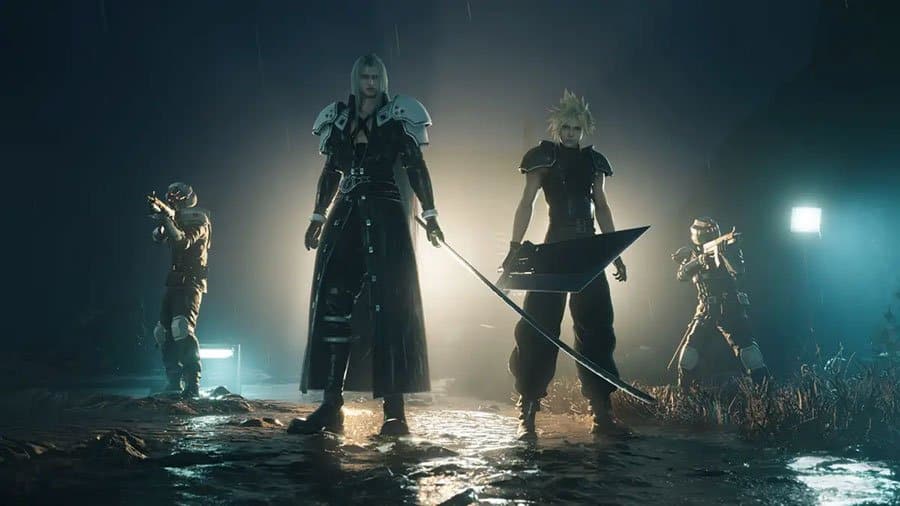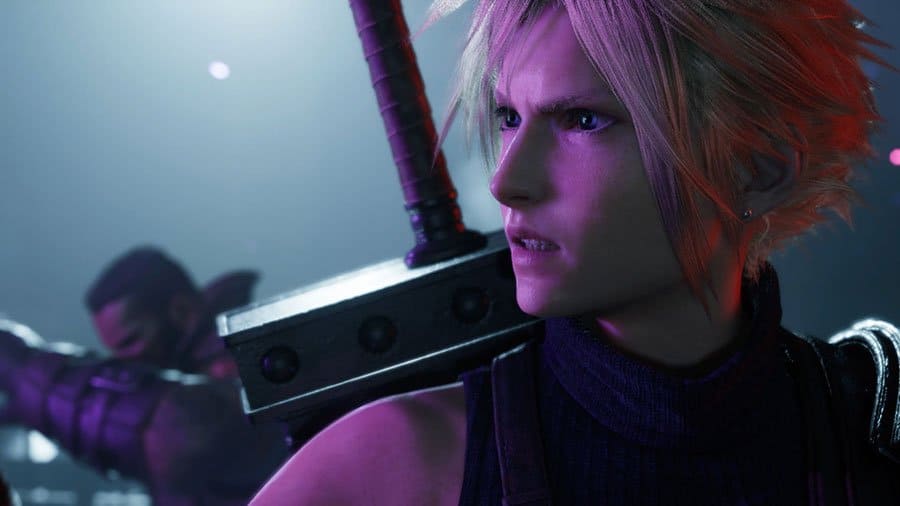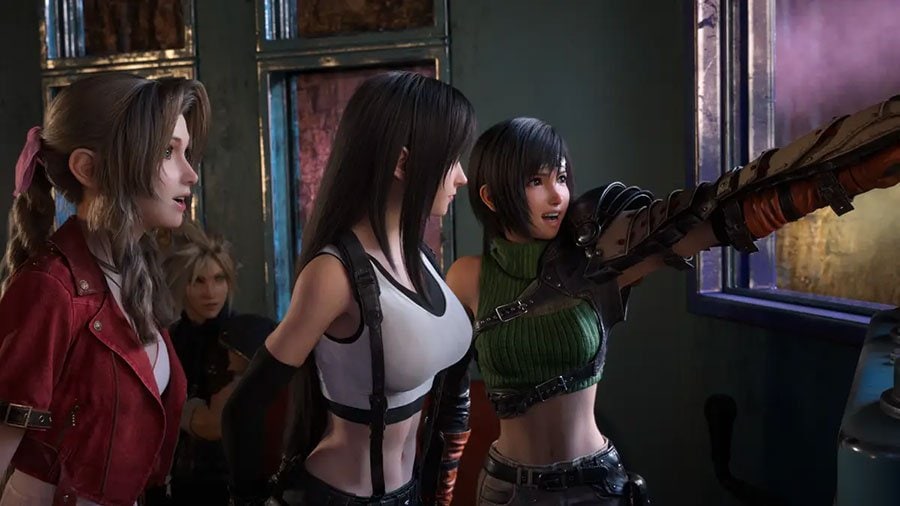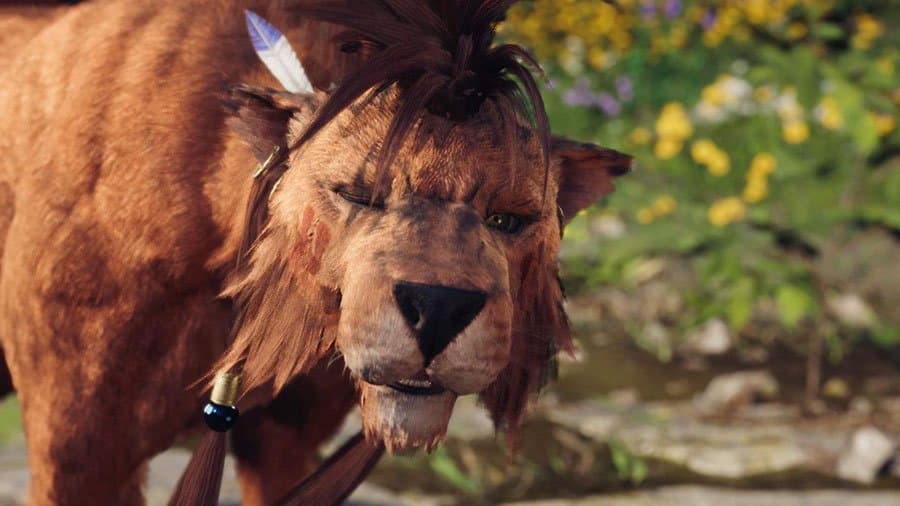Final Fantasy VII Rebirth Review – Saying Goodbye To An Old Friend

Whenever I introduce my career to someone for the first time, they always respond the same. They ask that fateful question, “what’s your favorite game of all time, then?” I always respond the same: it’s Final Fantasy VII.
Well, apart from that one time when I was on camera as a VIP at the launch event for the PlayStation 4, I panicked and said Digimon. Idiot.
Anyway, my love for Final Fantasy VII is no secret. Cloud has been my avatar on Twitter for years. My window sill is adorned with Cloud sitting atop the Fenrir and Barret striking a fearsome pose.
I have custom art of Cloud, Nanaki, Tifa, and Barret on my wall. I have an unopened deck of Cloud’s Final Fantasy TCG sitting on my desk because my friends all play Magic and think I’m sad.
I’m a fan, a fan stuck in his ways, but if any game can sway me to the modern direction Final Fantasy is taking, it’s Final Fantasy VII Rebirth.
Well, somewhat at least.
Final Fantasy VII Rebirth Review
The story events that unfold in Final Fantasy VII Rebirth stands as a once in a lifetime event, a convergence of elements made possible only through the meticulous planning of a trilogy of games interwoven with a beloved source material.
It’s unlikely we’ll ever see an event like this again. The narrative events that take place, both new and old, bring together events from Final Fantasy VII Remake and the original Final Fantasy VII in ways that are simply not possible for any other modern video-game release.
Seldom does a developer get to release a game all but guaranteed to have a trilogy of titles in which to weave a complex and immersive story. Square Enix took full advantage of this opportunity and left it nearly impossible to wait several more years for its conclusion.
Despite much of the story being a path well-travelled, Rebirth provides so much more depth to the characters and the world.
Like Remake before it, the modernizing of Final Fantasy VII’s story continues in epic fashion. The characters feel authentic, the voice acting fantastic and, ignoring some of the anime-style cringe moments, it’s simply the best telling of the story so far and one that is sure to resonate with fans of the original game.
Final Fantasy VII Rebirth’s Story Is A Once In A Lifetime Event
I wanted to scream from the rooftops. At every unexpected turn I urged for someone to share it with. Theories of what’s next swirling in my head at the breakfast table.
I’m not a fan of change and I really struggle when things come to a conclusion – it took me over a decade to finally finish Final Fantasy VII, despite reaching the end a dozen times.
I didn’t think it possible for me to walk away from a reimagining of the story with a positive outlook on what’s to come, but I cannot wait.
If you’re at all familiar with my Twitter feed, you’ve probably noticed my frequent appreciation for the golden era of turn-based RPGs. From the early Final Fantasy titles to gems like Shadow Hearts and Legends of Legaia, I’m always advocating for the inclusion of classic combat systems in modern video games.
Marvel’s Midnight Suns is one of the greatest turn-based games of all time, and I’ll die on that hill. This sentiment holds particularly true for remakes of games that played a foundational role in shaping today’s turn-based systems.
That said, Final Fantasy 7 Rebirth achieves a remarkable balance between turn-based and real-time combat, arguably approaching complete perfection in their synergy.
Never once did I avoid an enemy hoping to skip combat, never once was did I grow weary of repetitive hack-and-slash mechanics so often associated with real-time combat experiences.
From start to finish, I enjoyed every battle and the scaling difficulty options strike a perfect balance for all players.
Regardless of your skill level, your affinity for turn-based or real-time combat systems, fans of both approaches have all the tools they need to strike a balance between challenge and accessibility that is as welcoming to new players as it is challenging to experts of real-time combat systems – and I’m definitely not the latter.
As someone who would have told you, just weeks ago, that Final Fantasy turn-based will never be trumped by a real-time combat system, today I am happy to admit, I was wrong.
Experimenting with the different difficulty settings throughout much of the game is something I typically do in most games I review, but rarely do I spike up the difficulty at certain points on purpose.
Battling against the iconic summons from the franchise, taking one of the games many bosses down, pushing these fights to the peak of your personal ability level is as rewarding as it is challenging and I definitely recommend players experiment with these settings to truly appreciate the depth of the combat system.
On the battlefield, every single playable character is a main character in their own right. Each with an arsenal of different skills and abilities, each suited to different tasks, and each as vital as the next.
Getting to grips in the early hours of the game, I relied on singular characters, experimenting with different combinations of attacks to maximize damage. As the game unfolds and more characters joined the fray, I’d switch and learn more about my new allies.
Towards the latter stages, I was switching between abilities to capitalize on the synergy between multiple characters, stringing together attacks in seconds.
As someone who would have told you, just weeks ago, that Final Fantasy turn-based will never be trumped by a real-time combat system, today I am happy to admit that I was wrong.
If Final Fantasy VII Rebirth were to be judged solely on its combat and story, I’d argue that you’d be hard-pressed to find a more compelling narrative-driven RPG.
However, the game’s excellence in these aspects unfortunately isn’t mirrored across other areas of the game. While each of the regions within the game offer expansive, pseudo open-world environments teeming with quests, mini-games, and treasures, this is precisely where Rebirth falls short.
It recycles outdated and unimaginative open-world mechanics that were stale back in 2013, when the sixth Assassin’s Creed game had us climbing yet more towers.
Each region welcomes you with open arms, offering a warm embrace for fans of yesteryear. The visuals are stunning, and the accompanying soundtrack delivers a wave of nostalgia like no other.
The excitement of what you know is to come, the anticipation of what could be, every region filled with untapped potential – and that’s just 15 seconds after you’ve arrived.
However, before long, that warming embrace turns cold as the cursed repetition of the “open-world” experience sets in.
Final Fantasy VII Rebirth marks the very best in class across practically every element of game design for the Final Fantasy franchise, but I still couldn’t help but feel I was bidding farewell to an old friend.
Although each area is unique, and a visual splendor to enjoy, the path of discovery and exploration is well worn, walked just moments before in the previous region you visited.
You explore the area looking for towers to climb, which in turn reveals nearby points of interest, you interact with near identical points of interest to the last region, and you repeat.
Lifesprings, locations where Mako energy has condensed into beautiful crystalized form, offer meaningful insight into the history and events of each region, providing a charming way to connect the player to the world they are trying to save, the first few times.
Receiving a call from Chadley, annoyingly stopping you in your tracks, as he informs you of a mutated species nearby that needs “taking care of,” is interesting the first few times. Digging around for treasure with a Chocobo is fun, maybe the first time.
You repeat these same objectives for each of the games regions but the thrill of adventure and exploration dwindles with each repeated objective.
Final Fantasy VII is the game that taught me the golden rule of RPG exploration: You always go the wrong way first.
That game is nearly 30 years old, and it still remains unrivalled in how much reward there was to the exploration.
In today’s industry you would be utterly insane to expect a AAA developer to hide something as important as a character voiced by Matt Mercer in a place players could actually miss, but it was that love of exploration, that philosophy of reward that I feel lacks most in Final Fantasy VII Rebirth. Everything feels easy, almost spoon fed through fear of players missing out.
I never once had to buy a weapon, I found every single upgrade for every character with minimal effort. Whilst exploring the Grasslands I discovered this huge factory, sitting atop a cliff overlooking the rocky beach below.
In Cosmo Canyon, I studied strange Cactuar rocks and structures. In the Nibel Region I was stumped by these bizarre doors embedded into a rockface. What happened at all of these locations? Nothing, well, until I had collected the appropriate quest from a conveniently placed job board.
The environments of these open-world style areas feels fabricated, each location designed to serve a single purpose, a purpose chosen to be executed at a specific time and in a specific manner.
The game all too often controls when and where you can explore, when and where you can sprint or walk. Rebirth was never sold or described as a true open-world game but even in its more linear design, and as beautiful as the game world is, it’s left to feel like nothing more than a backdrop to the story.
It’s important for me to quickly follow up on that last bit as Rebirth’s other side content is actually incredible, ignoring the repetitive and unrewarding nature of exploration.
The side quest design in Rebirth sets a standard for modern RPGs. Each side quest presents players with a chance to delve deeper into the game’s world and the characters it brings to life.
These quests aren’t just mundane fetch tasks meant to boost character levels; rather, they offer invaluable insights into the rich universe of Final Fantasy VII and provide the chance to forge stronger connections with Cloud’s closest companions.
It very quickly offsets the disappointing nature of the open-area design with opportunities to explore the motives and emotions of the characters that the original Final Fantasy VII game just didn’t have the chance to do. And that’s without talking about the mini-games; oh boy.
I don’t even know where to begin. I honestly intended to count the individual mini-games as I progressed through the story but I lost count at 10.
Some, mere feeling moments offering fun and excitement, but others stand at the forefront of the experience, deeply engrained into the main story and it side content.
Queen’s Blood, a turn-based card game that sees both players attempting to win battles across three lanes, would easily be the single best mini-game a Final Fantasy game has ever produced – if it wasn’t for Blitzball.
Queen’s Blood is one of the greatest mini-games in modern gaming history
I’m an avid fan of Tetra Master, I’ve dedicated countless hours to the mastering of Triple Triad. However, both pale in comparison to the depth of Queen’s Blood.
It resembles more closely the complexity of games like Magic: The Gathering or Yugioh. It offers near endless opportunities for deck construction, experimenting with different tactics, strategies, and cards.
Undoubtedly, it stands out as one of the highlights of the entire Rebirth experience for me, and the accompanying narrative offers a captivating story into the life of its creator.
Chocobo Racing is another mini-game that plays a pivotal role in the main story, and some of the side content to boot.
The Mario Kart style drift and race mechanics are immediately familiar and while a bit more challenge and depth would have been welcomed (we miss Chocobo breeding), it’s just another one of many things that is the best in class for the Final Fantasy franchise.
It would be negligent of me to discuss the mini-games of Rebirth and not mention the Gold Saucer. I won’t get into specific details, you need to experience this for yourself, but it took a fan-favorite location from the original game and turned that dial up to 11, reimagined and revitalized to offer one of the most exciting areas of the entire game.
I could talk about this game forever. No other game has taken me on an emotional journey of this magnitude, the good and the bad.
The soundtrack is one of the best this industry has ever produced. Each character and their relationships given infinitely more time to shine and develop than the original game. Everything about this game is fantastic, but I still can’t shake a sinking feeling in the pit of my stomach.
Final Fantasy VII is the game that taught me the golden rule of RPG exploration, you always go the wrong way first.
My time through Final Fantasy VII Rebirth was profound. In one moment I was relishing in the opportunity to learn more about a world and characters I have loved for nearly 30 years. In the next, I was mourning the passing of principles and ideas that represent the very foundation of my love for the RPG genre and the Final Fantasy franchise as a whole.
Final Fantasy VII Rebirth marks the very best in class across practically every element of game design for the Final Fantasy franchise, but I still couldn’t help but feel I was bidding farewell to an old friend.
@GamersHeroes
@GamersHeroes
Final Fantasy VII Rebirth Review
Summary
My time through Final Fantasy VII Rebirth was profound. In one moment I was relishing in the opportunity to learn more about a world and characters I have loved for nearly 30 years. In the next, I was mourning the passing of principles and ideas that represent the very foundation of my love for the RPG genre and the Final Fantasy franchise as a whole. Final Fantasy VII Rebirth marks the very best in class across practically every element of game design for the Final Fantasy franchise, but I still couldn’t help but feel I was bidding farewell to an old friend.
| |
The best real-time combat system in a Final Fantasy game to-date
|
| |
Perfectly builds on the relationships of iconic characters 30 years in the making
|
| |
A gorgeous game world
|
| |
Incredible selection of mini-games
|
| |
Story may feel discombobulated to franchise newcomers
|
| |
Exploration isn’t as rewarding or satisfying as the original
|
| |
A pseudo open-world may disappoint some fans
|
Reviewed On: PlayStation 5 (A digital code was provided)
Released: February 29th, 2024
MSRP: $69.99 / £69.99
Platforms: PlayStation 5
Developer: Square Enix
Publisher: Square Enix
Alternative Reviews: Hey Poor Player, Easy Allies, The Outer Haven
Aggregate Scores: MetaCritic, Open Critic




